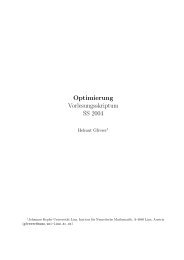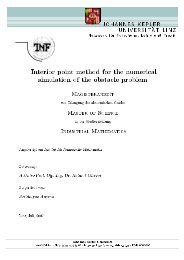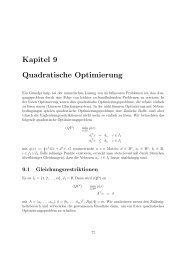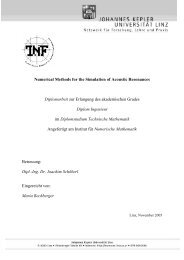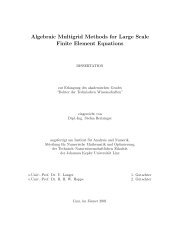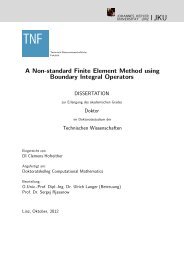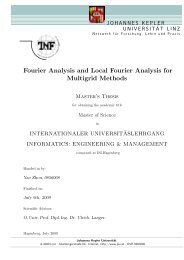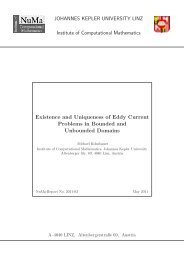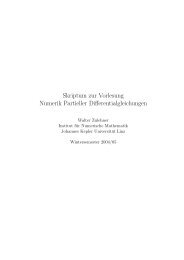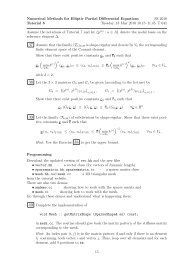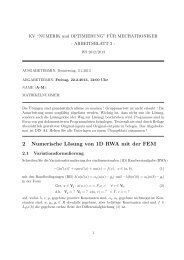Coupled FETI/BETI solvers for nonlinear potential problems in (un ...
Coupled FETI/BETI solvers for nonlinear potential problems in (un ...
Coupled FETI/BETI solvers for nonlinear potential problems in (un ...
You also want an ePaper? Increase the reach of your titles
YUMPU automatically turns print PDFs into web optimized ePapers that Google loves.
<strong>Coupled</strong> <strong>FETI</strong>/<strong>BETI</strong> <strong>solvers</strong> <strong>for</strong> <strong>nonl<strong>in</strong>ear</strong><br />
<strong>potential</strong> <strong>problems</strong> <strong>in</strong> (<strong>un</strong>)bo<strong>un</strong>ded doma<strong>in</strong>s<br />
Ulrich Langer 1,2 and Clemens Pechste<strong>in</strong> 2<br />
1 Institute of Computational Mathematics, Johannes Kepler University,<br />
Altenberger Str. 69, 4040 L<strong>in</strong>z, Austria ulanger@numa.<strong>un</strong>i-l<strong>in</strong>z.ac.at<br />
2 Special Research Program SFB F013, Johannes Kepler University, Altenberger<br />
Str. 69, 4040 L<strong>in</strong>z, Austria clemens.pechste<strong>in</strong>@numa.<strong>un</strong>i-l<strong>in</strong>z.ac.at<br />
Summary. In <strong>nonl<strong>in</strong>ear</strong> electromagnetic field computations, one is not only faced<br />
with large jumps of material coefficients across material <strong>in</strong>terfaces but also with<br />
high variation <strong>in</strong> these coefficients even <strong>in</strong>side homogeneous materials due to the<br />
<strong>nonl<strong>in</strong>ear</strong>ity. The radiation condition can conveniently be taken <strong>in</strong>to acco<strong>un</strong>t by a<br />
coupled bo<strong>un</strong>dary <strong>in</strong>tegral and doma<strong>in</strong> <strong>in</strong>tegral variational <strong>for</strong>mulation. The coupled<br />
f<strong>in</strong>ite and bo<strong>un</strong>dary element discretization leads to large-scale <strong>nonl<strong>in</strong>ear</strong> algebraic<br />
systems. In this paper we propose special <strong>in</strong>exact Newton methods where the Jacobi<br />
systems aris<strong>in</strong>g <strong>in</strong> every step of the Newton method are solved by a special preconditioned<br />
f<strong>in</strong>ite and bo<strong>un</strong>dary element tear<strong>in</strong>g and <strong>in</strong>terconnect<strong>in</strong>g solver. The numerical<br />
experiments show that the preconditioner proposed <strong>in</strong> the paper can handle<br />
large jumps <strong>in</strong> the coefficients across the material <strong>in</strong>terfaces as well as high variation<br />
<strong>in</strong> these coefficients on the subdoma<strong>in</strong>s. Furthermore, the convergence does not<br />
deteriorate if many <strong>in</strong>ner subdoma<strong>in</strong>s touch the <strong>un</strong>bo<strong>un</strong>ded exterior subdoma<strong>in</strong>.<br />
Key words: Nonl<strong>in</strong>ear <strong>problems</strong>, electromagnetic field computations, doma<strong>in</strong> decomposition,<br />
FEM, BEM, Newton’s methods, <strong>un</strong>bo<strong>un</strong>ded computational doma<strong>in</strong>s<br />
1 Introduction<br />
Doma<strong>in</strong> decomposition (DD) methods of iterative substructur<strong>in</strong>g type, such as the<br />
widely used classical f<strong>in</strong>ite element tear<strong>in</strong>g and <strong>in</strong>terconnect<strong>in</strong>g (<strong>FETI</strong>) methods [3],<br />
dual-primal <strong>FETI</strong> (<strong>FETI</strong>-DP) methods [4] and balanced doma<strong>in</strong> decomposition by<br />
constra<strong>in</strong>ts (BDDC) [5], are powerful methods <strong>for</strong> large-scale field computations on<br />
parallel computers. In the classical <strong>FETI</strong> method, the f<strong>in</strong>ite element subspaces are<br />
treated separately on each subdoma<strong>in</strong> <strong>in</strong>clud<strong>in</strong>g its bo<strong>un</strong>dary. The global cont<strong>in</strong>uity<br />
across the <strong>in</strong>terfaces is en<strong>for</strong>ced by Lagrange multipliers, which leads to a saddle<br />
po<strong>in</strong>t problem that can be solved iteratively via its dual problem. From the Lagrange<br />
multipliers, the solution can easily be computed. The iteration process is noth<strong>in</strong>g<br />
but a preconditioned conjugate gradient (PCG) subspace iteration.<br />
To obta<strong>in</strong> a fast method, a careful choice of the preconditioner is essential. For<br />
the case that the coefficients of the <strong>un</strong>derly<strong>in</strong>g elliptic partial differential equation
2 Ulrich Langer and Clemens Pechste<strong>in</strong><br />
(PDE) are constant <strong>in</strong> each subdoma<strong>in</strong>, quasi-optimal preconditioners are available.<br />
It is proved that the condition number grows proportionally to (1+log(H/h)) 2 , where<br />
h is the mesh size and H the average diameter of the subdoma<strong>in</strong>s. Moreover, the<br />
preconditioners are robust with respect to jumps <strong>in</strong> the coefficients across subdoma<strong>in</strong><br />
<strong>in</strong>terfaces [7, 13]. The PCG subspace iteration <strong>in</strong>volves the use of standard Dirichlet<br />
and Neumann <strong>solvers</strong>.<br />
To summarize, the ma<strong>in</strong> success of <strong>FETI</strong>, <strong>FETI</strong>-DP and BDDC methods is<br />
certa<strong>in</strong>ly due to their rather general structure, wide applicability, moderate complexity,<br />
robustness, and f<strong>in</strong>ally their scalability with respect to parallel comput<strong>in</strong>g.<br />
For a comprehensive <strong>in</strong>troduction to doma<strong>in</strong> decomposition methods, <strong>FETI</strong> and<br />
<strong>FETI</strong>-DP methods, we refer to the monograph by Toselli and Widl<strong>un</strong>d [18].<br />
Recently, Langer and Ste<strong>in</strong>bach have <strong>in</strong>troduced the bo<strong>un</strong>dary element tear<strong>in</strong>g<br />
and <strong>in</strong>terconnect<strong>in</strong>g (<strong>BETI</strong>) methods [11] as a bo<strong>un</strong>dary element co<strong>un</strong>terpart of<br />
the <strong>FETI</strong> methods, as well as the coupled <strong>FETI</strong>/<strong>BETI</strong> methods [12]. The <strong>BETI</strong><br />
method uses bo<strong>un</strong>dary-element-based analogs of the <strong>FETI</strong> operators. Due to spectral<br />
arguments, all the properties of <strong>FETI</strong> methods mentioned above rema<strong>in</strong> valid <strong>for</strong><br />
<strong>BETI</strong> methods. Furthermore, <strong>in</strong>exact and data-sparse techniques are available, cf.<br />
[9].<br />
Coupl<strong>in</strong>g bo<strong>un</strong>dary element and f<strong>in</strong>ite element discretizations, one can benefit<br />
from the advantages of both discretization techniques. For <strong>in</strong>stance, <strong>in</strong> electromagnetics,<br />
source terms and <strong>nonl<strong>in</strong>ear</strong>ities can be treated more efficiently by the f<strong>in</strong>ite<br />
element method (FEM) than by the bo<strong>un</strong>dary element method (BEM), whereas <strong>un</strong>bo<strong>un</strong>ded<br />
doma<strong>in</strong>s, mov<strong>in</strong>g parts and air regions can efficiently be handled by BEM.<br />
We refer to [2] <strong>for</strong> the symmetric coupl<strong>in</strong>g of f<strong>in</strong>ite and bo<strong>un</strong>dary elements, and to<br />
[6, 8] <strong>for</strong> us<strong>in</strong>g this coupl<strong>in</strong>g technique to construct doma<strong>in</strong> decomposition <strong>solvers</strong>.<br />
In this contribution, we use coupled <strong>FETI</strong>/<strong>BETI</strong> methods to solve <strong>nonl<strong>in</strong>ear</strong><br />
<strong>potential</strong> <strong>problems</strong> as they appear <strong>in</strong> <strong>nonl<strong>in</strong>ear</strong> magnetostatics <strong>in</strong> two dimensions,<br />
div(ν(x, |∇u(x)|)∇u(x)) = f(x) <strong>for</strong> x ∈ Ω . (1)<br />
Additionally we may have suitable transmission conditions, Dirichlet bo<strong>un</strong>dary conditions<br />
and/or–<strong>in</strong> case Ω is <strong>un</strong>bo<strong>un</strong>ded–a radiation condition.<br />
In Section 2 we give a review of the coupled <strong>FETI</strong>/<strong>BETI</strong> methods <strong>for</strong> the case<br />
that the coefficient ν is constant <strong>in</strong> the subdoma<strong>in</strong>s Ω i, consider<strong>in</strong>g a bo<strong>un</strong>ded<br />
doma<strong>in</strong> with Dirichlet bo<strong>un</strong>dary conditions.<br />
Solv<strong>in</strong>g the <strong>nonl<strong>in</strong>ear</strong> problem (1) <strong>in</strong> a bo<strong>un</strong>ded doma<strong>in</strong> Ω with <strong>FETI</strong>/<strong>BETI</strong><br />
methods has been <strong>in</strong>vestigated by the present authors <strong>in</strong> [10]. We give an outl<strong>in</strong>e of<br />
the ma<strong>in</strong> issues <strong>in</strong> Section 3. Apply<strong>in</strong>g Newton’s method to the global <strong>for</strong>mulation,<br />
the spectrum of the Jacobi matrices <strong>in</strong> the <strong>nonl<strong>in</strong>ear</strong> subdoma<strong>in</strong>s may show high<br />
variation, especially if there are s<strong>in</strong>gularities <strong>in</strong> the solution. We propose a special<br />
preconditioner to overcome these difficulties and show its good numerical behavior<br />
<strong>in</strong> a typical magnetostatic model problem.<br />
Section 4 is devoted to <strong>un</strong>bo<strong>un</strong>ded doma<strong>in</strong>s. We show how the <strong>BETI</strong> operators<br />
change and give some analytic results. Up to now, we can only prove a suboptimal<br />
condition number estimate whereas the per<strong>for</strong>mance of the numerical experiments<br />
is far more promis<strong>in</strong>g.
<strong>Coupled</strong> <strong>FETI</strong>/<strong>BETI</strong> <strong>solvers</strong> – <strong>nonl<strong>in</strong>ear</strong>, <strong>un</strong>bo<strong>un</strong>ded 3<br />
2 <strong>Coupled</strong> <strong>FETI</strong>/<strong>BETI</strong> Methods<br />
Let Ω ⊂ R d (where d = 2, 3) be a bo<strong>un</strong>ded, connected doma<strong>in</strong> with a Lipschitz<br />
bo<strong>un</strong>dary Γ and the outward <strong>un</strong>it normal vector n. We assume that Ω is decomposed<br />
<strong>in</strong>to p non-overlapp<strong>in</strong>g simply-connected Lipschitz doma<strong>in</strong>s Ω i, i. e. Ω = S p<br />
i=1<br />
Ωi. It<br />
is assumed that the diameters H i = diam Ω i are all of comparable size and bo<strong>un</strong>ded<br />
by the maximal diameter H. We def<strong>in</strong>e the local bo<strong>un</strong>daries Γ i = ∂Ω i and the<br />
<strong>in</strong>terfaces Γ ij = Ω i ∩ Ω j, and denote the outward <strong>un</strong>it normal vector on Γ i by<br />
n i. In the follow<strong>in</strong>g, we consider the Poisson problem with homogeneous Dirichlet<br />
bo<strong>un</strong>dary conditions and piecewise constant coefficients, to f<strong>in</strong>d u satisfy<strong>in</strong>g<br />
−div(α i∇u) = f <strong>in</strong> Ω i ,<br />
u = 0 on Γ ,<br />
α i<br />
∂u<br />
∂n i<br />
+ α j<br />
∂u<br />
∂n j<br />
= 0 on Γ ij ,<br />
(2)<br />
with α i = const. The generalization to <strong>in</strong>homogeneous and mixed bo<strong>un</strong>dary conditions<br />
is straight<strong>for</strong>ward.<br />
2.1 Dirichlet-to-Neumann maps<br />
The solution u i of the local subproblem<br />
−div(α i∇u i) = 0 <strong>in</strong> Ω i , u i = g i on Γ i , (3)<br />
∂u<br />
def<strong>in</strong>es the Steklov-Po<strong>in</strong>caré operator S i g i := α i i ∂n i<br />
, mapp<strong>in</strong>g the Dirichlet trace g i<br />
to the correspond<strong>in</strong>g Neumann trace. The contribution of a right hand side f i to the<br />
∂v<br />
Neumann trace of the solution is described by the Newton <strong>potential</strong> N i f i = −α i i ∂n i<br />
,<br />
where v i solves<br />
−div(α i∇v i) = f i <strong>in</strong> Ω i , v i = 0 on Γ i . (4)<br />
These operators can be approximated by the FEM. Fix<strong>in</strong>g a triangulation T i, h of<br />
Ω i with a mesh size h, we denote by K i the FEM stiffness matrix and partition it<br />
accord<strong>in</strong>g to bo<strong>un</strong>dary <strong>un</strong>knowns (subscript Γ) and <strong>in</strong>ner <strong>un</strong>knowns (subscript I).<br />
The Schur complement<br />
S FEM<br />
i, h := K II, i − K ΓI, i K −1<br />
II, i K IΓ, i (5)<br />
is a symmetric and stable approximation of S i, and<br />
N FEM<br />
i, h f i<br />
:= f Γ, i<br />
− K ΓI, i K −1<br />
II, i f I i<br />
(6)<br />
is a stable approximation of the Newton <strong>potential</strong> N i, cf. [17].<br />
On the other hand, one can approximate the Steklov-Po<strong>in</strong>caré operator by means<br />
of the BEM, cf. [6, 17]. The solution of (3) satisfies the Caldéron equation<br />
„ « „ αi<br />
« „ «<br />
gi<br />
= 2<br />
I − K i V i gi<br />
α<br />
t i D i i 2<br />
I + K i<br />
′ (7)<br />
t i<br />
where t i is the co-normal derivative and V i, K i, K ′ i, D i are the usual bo<strong>un</strong>dary<br />
<strong>in</strong>tegral operators, the s<strong>in</strong>gle layer <strong>potential</strong> operator, the double layer <strong>potential</strong><br />
operator, its adjo<strong>in</strong>t, and the hypers<strong>in</strong>gular <strong>in</strong>tegral operator, respectively. In three
4 Ulrich Langer and Clemens Pechste<strong>in</strong><br />
dimensions the s<strong>in</strong>gle layer <strong>potential</strong> operator V i is always elliptic, whereas <strong>in</strong> two<br />
dimensions, due to the logarithm <strong>in</strong> the f<strong>un</strong>damental solution, it is only elliptic if<br />
diam Ω i < 1. This property can always be achieved by a suitable coord<strong>in</strong>ate scal<strong>in</strong>g.<br />
After discretiz<strong>in</strong>g and elim<strong>in</strong>at<strong>in</strong>g t i, one obta<strong>in</strong>s the symmetric and stable approximation<br />
Si, BEM<br />
h := D i, h + ` α i<br />
2<br />
Mi, ⊤ h + Ki, ⊤ −1` h<br />
´V<br />
αi<br />
i, h 2<br />
M i, h + K i, h´<br />
, (8)<br />
where V i, h , K i, h , D i, h are the bo<strong>un</strong>dary element matrices correspond<strong>in</strong>g to V i, K i,<br />
D i, respectively, and M i, h is a mass matrix.<br />
Note that the two approximations Si, FEM<br />
h and Si, BEM<br />
h are compatible and both<br />
spectrally equivalent to the Galerk<strong>in</strong> matrices of the exact Steklov-Po<strong>in</strong>caré operators<br />
S i. The application of Si, FEM<br />
h or Si, BEM<br />
h simply corresponds to the solution of<br />
local Dirichlet <strong>problems</strong>. For details we refer to [11, 12].<br />
2.2 Tear<strong>in</strong>g and Interconnect<strong>in</strong>g<br />
Introduc<strong>in</strong>g separate variables u i on the local subdoma<strong>in</strong>s, one can re-en<strong>for</strong>ce the<br />
cont<strong>in</strong>uity of the solution u across <strong>in</strong>terfaces Γ ij by the constra<strong>in</strong>ts<br />
X p<br />
Bi ui = 0 , (9)<br />
i=1<br />
where the B i are <strong>in</strong>cidence matrices.<br />
Problem (2) can be written as a constra<strong>in</strong>t m<strong>in</strong>imization problem, as well as a<br />
saddle po<strong>in</strong>t problem <strong>in</strong>volv<strong>in</strong>g Lagrange multipliers. Us<strong>in</strong>g the notion of the pseudo<strong>in</strong>verse<br />
( † ) and a special projection P address<strong>in</strong>g the kernels of the sub<strong>problems</strong>, it<br />
is possible to elim<strong>in</strong>ate the primal <strong>un</strong>knowns u i. F<strong>in</strong>ally, one obta<strong>in</strong>s the discrete<br />
dual <strong>FETI</strong>/<strong>BETI</strong> <strong>for</strong>mulation, to f<strong>in</strong>d the Lagrange multiplier λ such that<br />
where the <strong>FETI</strong>/<strong>BETI</strong> operator F is def<strong>in</strong>ed by<br />
F = B<br />
where B = ˆB i˜p<br />
, i=1 SFEM/BEM h<br />
:=<br />
P T F λ = d, (10)<br />
FEM/BEM˜† ˆSh<br />
B ⊤ = X p<br />
˜†<br />
Bi<br />
ˆSFEM/BEM<br />
i=1<br />
i,h<br />
Bi ⊤ , (11)<br />
FEM/BEM˜p<br />
ˆSi, h<br />
. The application of the pseudo-<br />
i=1<br />
<strong>in</strong>verses [S FEM/BEM<br />
i, h<br />
] † can be realized by the simple solution of regularized local Neumann<br />
<strong>problems</strong>. S<strong>in</strong>ce F is symmetric positive def<strong>in</strong>ite on range(P), one can solve<br />
the dual problem (10) by a preconditioned conjugate gradient subspace iteration.<br />
The preconditioner<br />
M −1<br />
S,α = (BD −1<br />
α B ⊤ ) −1 BD α S FEM/BEM<br />
h<br />
D αB ⊤ (BD −1<br />
α B ⊤ ) −1 , (12)<br />
first <strong>in</strong>troduced and fully analyzed by Klawonn and Widl<strong>un</strong>d [7], satisfies the quasioptimal<br />
condition number estimate<br />
κ(PM −1<br />
S,αP T P T FP) ≤ C(1 + log(H/h)) 2 , (13)<br />
<strong>in</strong>dependent of the values–and there<strong>for</strong>e possible jumps–of the coefficients α i. It is<br />
well known that an appropriate norm of the<br />
√iteration error of the conjugate gradient<br />
method will decrease at least by a factor 2` κ−1<br />
´n<br />
√ κ+1<br />
<strong>in</strong> n steps. The robustness with
<strong>Coupled</strong> <strong>FETI</strong>/<strong>BETI</strong> <strong>solvers</strong> – <strong>nonl<strong>in</strong>ear</strong>, <strong>un</strong>bo<strong>un</strong>ded 5<br />
respect to the jumps <strong>in</strong> the coefficients α i is due to the special diagonal scal<strong>in</strong>g<br />
matrix D α, <strong>in</strong>volv<strong>in</strong>g weighted mean values of α i on cross po<strong>in</strong>ts, <strong>in</strong>terface l<strong>in</strong>es and<br />
<strong>in</strong>terfaces between the subdoma<strong>in</strong>s. We further po<strong>in</strong>t out that one step of the PCG<br />
subspace iteration is per<strong>for</strong>med by the solution of one local Dirichlet and one local<br />
Neumann problem on each of the subdoma<strong>in</strong>s, and the application of the projection<br />
and some scal<strong>in</strong>g matrices, which are both global operations but of a rather small<br />
dimension. This is why these tear<strong>in</strong>g and <strong>in</strong>terconnect<strong>in</strong>g methods are most suitable<br />
<strong>for</strong> parallelization. For a more detailed description see e. g. [7, 10, 12]<br />
2.3 Vary<strong>in</strong>g coefficients<br />
In this subsection, we consider a vary<strong>in</strong>g matrix coefficient A i(x) <strong>in</strong>stead of a constant<br />
coefficient α i on some of the subdoma<strong>in</strong>s discretized by the FEM. We assume<br />
A i(x) to be constant on the f<strong>in</strong>ite elements T ∈ T i, h . In order to determ<strong>in</strong>e the<br />
amo<strong>un</strong>t of variance, we <strong>in</strong>troduce the spectral variance measure<br />
m SV (A i) := sup x∈Ω i<br />
α i (x)<br />
<strong>in</strong>f x∈Ωi α i (x) , (14)<br />
where α i(x) and α i<br />
(x) denote the maximal and m<strong>in</strong>imal local eigenvalues of A i(x),<br />
respectively. The application of a preconditioner with Steklov-Po<strong>in</strong>caré operators<br />
correspond<strong>in</strong>g to constant coefficients leads <strong>in</strong> the worst case to a condition number<br />
proportional to max i m SV (A i), which is not at all acceptable <strong>in</strong> magnetostatic<br />
applications. In [10] the present authors have proposed a new preconditioner M c−1<br />
S,A<br />
based on a vary<strong>in</strong>g scalar coefficient bα i(x) which can be easily computed from A i(x),<br />
together with a suitable diagonal scal<strong>in</strong>g matrix D bα . If the local anisotropy measure<br />
m anis(A i) := sup x∈Ωi<br />
α i (x)<br />
α i (x)<br />
(15)<br />
is moderate, our new preconditioner works f<strong>in</strong>e, cf. Table 1 and [10].<br />
3 Nonl<strong>in</strong>ear Problems<br />
We now consider the follow<strong>in</strong>g <strong>nonl<strong>in</strong>ear</strong> magnetostatic model problem:<br />
−div[ν i(|∇u|)∇u] = f <strong>in</strong> Ω i ,<br />
u = 0 on Γ ,<br />
ν i(|∇u|) ∂u<br />
∂n i<br />
+ ν j(|∇u|) ∂u<br />
∂n j<br />
= 0 on Γ ij .<br />
Assum<strong>in</strong>g that the f<strong>un</strong>ctions t ↦→ ν i(t)t : [0, ∞) → [0, ∞) are strongly monotonically<br />
<strong>in</strong>creas<strong>in</strong>g and piecewise C 2 , (16) is <strong>un</strong>iquely solvable <strong>in</strong> the weak sense and<br />
the correspond<strong>in</strong>g Newton iteration converges locally at a quadratic rate. For our<br />
computations, we generated these material curves from noisy measurements us<strong>in</strong>g<br />
the robust <strong>in</strong>terproximation technique <strong>in</strong>troduced by Pechste<strong>in</strong> and Jüttler <strong>in</strong><br />
[15]. In the l<strong>in</strong>earized <strong>problems</strong> a vary<strong>in</strong>g matrix coefficient ζ i(∇u (k)<br />
h<br />
(x)) appears.<br />
In our numerical experiments, it turns out that typically the anisotropy measure<br />
m anis(ζ i(∇u (k)<br />
h<br />
)) is small, whereas the spectral variance measure m SV(ζ i(∇u (k)<br />
h ))<br />
becomes rather large. As one can observe <strong>in</strong> Table 1, with our new preconditioner<br />
cM −1<br />
S,A<br />
such l<strong>in</strong>earized Newton-<strong>problems</strong> can be solved satisfactorily. In order to get<br />
a good <strong>in</strong>itial guess <strong>for</strong> Newton’s iteration, it is convenient to set up a hierarchy<br />
of nested grids and use coarse grid solutions as <strong>in</strong>itial guesses on f<strong>in</strong>er levels. For<br />
details, see [10].<br />
(16)
6 Ulrich Langer and Clemens Pechste<strong>in</strong><br />
d.o.f. Lagr. H/h m anis(ζ) m SV (ζ) Newt. PCG-steps ref<br />
806 408 6.3 12.0 187.4 6 14.0 12<br />
3539 777 12.6 12.0 469.9 4 17.8 14<br />
14357 1515 25.3 12.0 852.4 4 21.3 17<br />
57833 2991 20.6 12.0 1496.4 3 25.3 19<br />
232145 5943 101.2 12.4 2670.9 4 27.8 21<br />
Table 1. Average number of <strong>FETI</strong> PCG iterations to get a reduction of 10 −8 <strong>in</strong><br />
the residual of l<strong>in</strong>ear sub<strong>problems</strong> dur<strong>in</strong>g Newton’s iteration, with 70 subdoma<strong>in</strong>s,<br />
compared to a l<strong>in</strong>ear reference problem (ref.) of the same size.<br />
4 Unbo<strong>un</strong>ded doma<strong>in</strong>s<br />
In this section we allow that one of the subdoma<strong>in</strong>s, namely Ω 0, is the <strong>un</strong>bo<strong>un</strong>ded<br />
exterior ext(Γ 0) of its bo<strong>un</strong>dary Γ 0, where the <strong>in</strong>terior <strong>in</strong>t(Γ 0) is bo<strong>un</strong>ded. Usually,<br />
<strong>for</strong> a typical doma<strong>in</strong> decomposition, H 0 := diam <strong>in</strong>t(Γ 0) ≫ H i <strong>for</strong> i ≠ 0. In Ω 0, we<br />
assume that the homogeneous Poisson equation is satisfied together with a suitable<br />
radiation condition, e.g. <strong>for</strong> d = 3,<br />
−α 0∆u = 0 <strong>in</strong> Ω 0 , |u(x)| = O(|x| −1 ) <strong>for</strong> |x| → ∞ , (17)<br />
cf. [14, 16]. In magnetostatic field computations, α 0 could equal 1/µ 0, where µ 0 is<br />
the permeability of vacuum. The Dirichlet-to-Neumann map on Ω 0 reads<br />
S0 ext = D 0 + ` α 0<br />
´ `<br />
2<br />
I − K 0<br />
′ V−1 α0<br />
0 2<br />
I − K 0´<br />
. (18)<br />
This means the difference between the <strong>in</strong>terior and exterior Steklov-Po<strong>in</strong>caré operator<br />
is just the sign <strong>in</strong> front of the double layer <strong>potential</strong> operators K and K ′ . As<br />
a consequence, S0 ext is always a one-to-one mapp<strong>in</strong>g, and Ω 0 must be treated as a<br />
non-float<strong>in</strong>g subdoma<strong>in</strong>, cf. [7]. It can be shown that<br />
〈S ext<br />
0 v, v〉 ≃ |v| 2 H 1/2 (Γ 0 ) + 1<br />
H 0<br />
‖v‖ 2 L 2 (Γ 0 ) , (19)<br />
where <strong>in</strong> two dimensions the coord<strong>in</strong>ates have to be scaled such that H 0 ≃ 1. The<br />
BEM-approximation of S0 ext works analogously to (8).<br />
By means of Sobolev <strong>in</strong>terpolation techniques and the auxiliary results stated <strong>in</strong><br />
[7, 18], one can show that the <strong>FETI</strong>/<strong>BETI</strong> preconditioner def<strong>in</strong>ed <strong>in</strong> (12) yields the<br />
follow<strong>in</strong>g condition number estimate <strong>in</strong> the presence of one exterior doma<strong>in</strong> Ω 0,<br />
“ “ ”” 2<br />
κ(P M −1<br />
S,α P ⊤ P ⊤ H<br />
F P) ≤ C 1 + log max F<br />
F ⊂Γ<br />
h F<br />
max<br />
H 0<br />
S F ⊂Γ<br />
H 0 F<br />
, (20)<br />
where Γ S = S p<br />
i=1<br />
Γi is the skeleton of the doma<strong>in</strong> decomposition, and F r<strong>un</strong>s over<br />
<strong>in</strong>terfaces of subdoma<strong>in</strong>s, i. e. F = Γ ij <strong>for</strong> some i ≠ j, and H F := diam F. By h F<br />
we denote the m<strong>in</strong>imal mesh size on the <strong>in</strong>terface F. As <strong>in</strong> the standard case, C is<br />
<strong>in</strong>dependent of the diameters H i, H F, the mesh size h F and possible jumps <strong>in</strong> the<br />
coefficients α i.<br />
Note that ( H 0<br />
H F<br />
) d−1 is proportional to the number of subdoma<strong>in</strong>s touch<strong>in</strong>g Γ 0.<br />
Our first numerical experiments show even better per<strong>for</strong>mance than expected from
<strong>Coupled</strong> <strong>FETI</strong>/<strong>BETI</strong> <strong>solvers</strong> – <strong>nonl<strong>in</strong>ear</strong>, <strong>un</strong>bo<strong>un</strong>ded 7<br />
p H 0/H F (H F/h F) 4 8 16 32<br />
10 3 (PCG) 8 9 11 13<br />
37 6 9 11 13 16<br />
145 12 9 13 15 17<br />
577 24 11 14 16 –<br />
2305 48 12 – – –<br />
Table 2. Iteration numbers of the PCG subspace iteration of the <strong>FETI</strong>/<strong>BETI</strong><br />
method <strong>in</strong> presence of a twodimensional exterior doma<strong>in</strong>. p: Number of subdoma<strong>in</strong>s.<br />
the estimate (20). In Table 2 one can observe a logarithmic <strong>in</strong>stead of a l<strong>in</strong>ear growth<br />
<strong>in</strong> the condition numbers, when <strong>in</strong>creas<strong>in</strong>g H 0<br />
H F<br />
.<br />
Whenever comput<strong>in</strong>g on parallel mach<strong>in</strong>es with such exterior doma<strong>in</strong>s, one has<br />
to keep the load balanc<strong>in</strong>g of the processors <strong>in</strong> m<strong>in</strong>d. Our suggestion is either to use<br />
a special decomposition with different mesh sizes to obta<strong>in</strong> balance, or to treat the<br />
exterior subdoma<strong>in</strong> on a group of processors and apply an <strong>in</strong>ner parallelization of<br />
the correspond<strong>in</strong>g local problem, e.g. us<strong>in</strong>g the techniques described <strong>in</strong> [1] and the<br />
references there<strong>in</strong>. In experiments, we have observed that <strong>for</strong> <strong>nonl<strong>in</strong>ear</strong> <strong>problems</strong> <strong>in</strong><br />
<strong>un</strong>bo<strong>un</strong>ded doma<strong>in</strong>s, a coarse solution of a homogeneous Dirichlet problem (without<br />
consider<strong>in</strong>g the exterior doma<strong>in</strong>) may serve as a good <strong>in</strong>itial guess <strong>for</strong> the Newton<br />
iteration on the f<strong>in</strong>e level <strong>in</strong>clud<strong>in</strong>g the exterior doma<strong>in</strong>.<br />
5 Conclusion<br />
In this work we gave an overview on the standard <strong>FETI</strong> and <strong>BETI</strong> methods <strong>for</strong><br />
l<strong>in</strong>ear large-scale <strong>potential</strong> <strong>problems</strong> on bo<strong>un</strong>ded doma<strong>in</strong>s, and an outl<strong>in</strong>e on how<br />
to extend and use these techniques <strong>in</strong> the presence of <strong>nonl<strong>in</strong>ear</strong>ities and <strong>un</strong>bo<strong>un</strong>ded<br />
doma<strong>in</strong>s. Our numerical results are rather promis<strong>in</strong>g <strong>in</strong> both cases.<br />
For a proof of the effectiveness of our new preconditioner that can be applied<br />
to <strong>nonl<strong>in</strong>ear</strong> <strong>problems</strong>, an analysis of <strong>FETI</strong>/<strong>BETI</strong> methods <strong>for</strong> vary<strong>in</strong>g coefficients<br />
is needed, which is certa<strong>in</strong>ly a challeng<strong>in</strong>g subject of future research. For the <strong>un</strong>bo<strong>un</strong>ded<br />
case, we could give gave some analysis lead<strong>in</strong>g to a suboptimal condition<br />
number estimate, while our numerical experiments show an even better, quasioptimal<br />
behavior.<br />
Acknowledgments<br />
The authors would like to thank Olaf Ste<strong>in</strong>bach and Günther Of (Graz University of<br />
Technology, Austria) <strong>for</strong> fruitful discussions, and gratefully acknowledge the f<strong>in</strong>ancial<br />
support of the Austrian Grid project and the FWF (Austrian Science F<strong>un</strong>ds)<br />
Special Research Program SFB F013. We remark that <strong>in</strong> our numerical experiments<br />
we have used PARDISO (www.computational.<strong>un</strong>ibas.ch/cs/scicomp) as a sparse<br />
direct l<strong>in</strong>ear solver and Ste<strong>in</strong>bach’s BEM-package OSTBEM.
8 Ulrich Langer and Clemens Pechste<strong>in</strong><br />
References<br />
1. A<strong>in</strong>sworth, M. and Guo, B.: Analysis of iterative sub-structur<strong>in</strong>g techniques <strong>for</strong><br />
bo<strong>un</strong>dary element approximation of the hypers<strong>in</strong>gular operator <strong>in</strong> three dimensions,<br />
Appl. Anal. 81(2), 241–280 (2002)<br />
2. Costabel, M.: Symmetric coupl<strong>in</strong>g of f<strong>in</strong>ite elements and bo<strong>un</strong>dary elements. In:<br />
Brebbia, C.A., Kuhn, G., Wendland, W.L. (ed.) Bo<strong>un</strong>dary elements IX, 411–420,<br />
Spr<strong>in</strong>ger, Berl<strong>in</strong> (1987)<br />
3. Farhat, C. and Roux, F.-X.: A method of f<strong>in</strong>ite element tear<strong>in</strong>g and <strong>in</strong>terconnect<strong>in</strong>g<br />
and its parallel solution algorithm, Int. J. Numer. Meth. Engrg., 32,<br />
1205–1227 (1991)<br />
4. Farhat, C., Leso<strong>in</strong>ne, M., and Pierson, K.: A scalable dual-primal doma<strong>in</strong> decomposition<br />
method, Numer. L<strong>in</strong>ear Algebra Appl., 7, 687–714 (2000)<br />
5. Dohrmann, C.R.: A preconditioner <strong>for</strong> substructur<strong>in</strong>g based on constra<strong>in</strong>ed energy<br />
m<strong>in</strong>imization, SIAM J. Sci. Comput., 25(1), 246–258 (2003)<br />
6. Hsiao, G.C., Ste<strong>in</strong>bach, O., Wendland, W.L.: Doma<strong>in</strong> decomposition methods<br />
via bo<strong>un</strong>dary <strong>in</strong>tegral equations, J. Comput. Appl. Math., 125, 521–537 (2000)<br />
7. Klawonn, A., Widl<strong>un</strong>d, O.B.: <strong>FETI</strong> and Neumann-Neumann iterative substructur<strong>in</strong>g<br />
methods: Connections and new results, Comm. Pure Appl. Math., 54,<br />
57–90 (2001)<br />
8. Langer, U.: Parallel iterative solution of symmetric coupled FE/BE-equations via<br />
doma<strong>in</strong> decomposition, Contemp. Math., 157, 335–344 (1994)<br />
9. Langer, U., Of, G., Ste<strong>in</strong>bach, O., Zulehner, W.: Inexact data-sparse bo<strong>un</strong>dary<br />
element tear<strong>in</strong>g and <strong>in</strong>terconnect<strong>in</strong>g methods, SIAM J. Sci. Comp., 29(1), 290–<br />
314 (2007)<br />
10. Langer, U., Pechste<strong>in</strong>, C.: <strong>Coupled</strong> f<strong>in</strong>ite and bo<strong>un</strong>dary element tear<strong>in</strong>g and<br />
<strong>in</strong>terconnect<strong>in</strong>g <strong>solvers</strong> <strong>for</strong> <strong>nonl<strong>in</strong>ear</strong> <strong>potential</strong> <strong>problems</strong>, ZAMM - J. Appl. Math.<br />
Mech., 86(12), 915–931 (2006)<br />
11. Langer, U., Ste<strong>in</strong>bach, O.: Bo<strong>un</strong>dary element tear<strong>in</strong>g and <strong>in</strong>terconnect<strong>in</strong>g methods,<br />
Comput<strong>in</strong>g, 71(3), 205–228 (2003)<br />
12. Langer, U., Ste<strong>in</strong>bach, O.: <strong>Coupled</strong> bo<strong>un</strong>dary and f<strong>in</strong>ite element tear<strong>in</strong>g and<br />
<strong>in</strong>terconnect<strong>in</strong>g methods. In: Kornhuber, R., Hoppe, R., Periaux, J., Pironneau,<br />
O., Widl<strong>un</strong>d, O., Xu, J. (ed.) Proceed<strong>in</strong>gs of the 15th <strong>in</strong>t. conference on doma<strong>in</strong><br />
decomposition. LNCSE, 40, 83–97, Spr<strong>in</strong>ger, Heidelberg (2004)<br />
13. Mandel, J., Dohrmann, C.R., Tezaur, R.: An algebraic theory <strong>for</strong> primal and<br />
dual substructur<strong>in</strong>g methods by constra<strong>in</strong>ts, App. Num. Math., 54, 167–193<br />
(2005)<br />
14. McLean, W.: Strongly elliptic systems and bo<strong>un</strong>dary <strong>in</strong>tegral equations, Cambridge<br />
University Press (2000)<br />
15. Pechste<strong>in</strong>, C., Jüttler, B.: Monotonicity-preserv<strong>in</strong>g <strong>in</strong>terproximation of B-Hcurves,<br />
J. Comp. Appl. Math., 196, 45–57 (2006)<br />
16. Ste<strong>in</strong>bach, O.: Numerische Näher<strong>un</strong>gsverfahren für elliptische Randwertprobleme.<br />
F<strong>in</strong>ite Elemente <strong>un</strong>d Randelemente. B.G. Teubner, Stuttgart, Leipzig,<br />
Wiesbaden (2003)<br />
17. Ste<strong>in</strong>bach, O.: Stability estimates <strong>for</strong> hybrid coupled doma<strong>in</strong> decomposition<br />
methods, Lecture Notes <strong>in</strong> Mathematics, 1809, Spr<strong>in</strong>ger, Berl<strong>in</strong> Heidelberg<br />
(2003)<br />
18. Toselli, A., Widl<strong>un</strong>d, O.: Doma<strong>in</strong> decomposition methods – Algorithms and<br />
theory, Spr<strong>in</strong>ger Series <strong>in</strong> Computational Mathematics, 34, Spr<strong>in</strong>ger, New York<br />
(2005)



